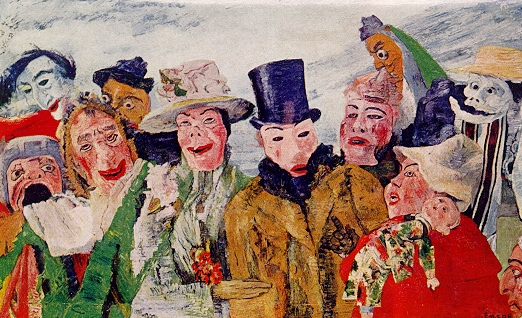At some point the sublimity of spirituality becomes corrupted, infected and toxified with religious hallucinations embedded with supersitition and fantastic images from the recesses of the mind. An addiction to the subjective roots of ostensibly objective problems. James Ensor could never qualify as really mad. It wan an expression of fear and a heightened level of misanthropy where a world of hallucinations becomes the real word. Anchorless, rootless, it floats in a zone of insanity with knowing it; a meta commentary while breaking with the external world and commenting as insane on the knowingly insane. Like thinking about your thinking except here the link with the external world is ruptured and the nightmarish invades the internal.

---As I said he’s got a very dark sense of humor which, interestingly, is often contrasted by very light, bright canvases. In his painting Masks Mocking Death, Death wears mostly white and has on a funny hat that looks almost like it’s designed by Dr. Seuss. In a review of the exhibit in Time, Richard Lacayo says Death “looks as if he knows he’s going to get the last laugh.” Well, actually to me it looks as if Death might be grinding his teeth in frustration–annoyed that he’s being mocked. Or maybe he just doesn’t give a damn.--- Read More:http://just-write.contentquake.com/2009/08/19/historical-nourishment/
Within a broader context, what Ensor was striking at, was that the more patently fraudulently, staged and manufactured, mass produced madness appears, escapism, the less the masses have to confront and fear their own madness : their own personal insanity. Another dark side of Walter Benjamin’s mechanical reproduction to repress madness until the inevitable bubbles pop.There is a rigid formal structure that you can assert your individuality and personality within and generate the comparative preferences necessary to foster consumerism, but that structure is wholly contrived. It could be seen as an affliction with normality. … ( Kuspit): “In part this means that they never put themselves into question, which would make them ill, if not creatively ill, although eventually they would have to become creative, and transgress the norm of normality, if they are to find an answer to themselves, however tentative.”

James Ensor. The Intrigue. 1890.---Like many other artists of the macabre, James Ensor was a misfit toy: he spent most of his days living above the curio shop owned by his parents in Ostend, Belgium. After his parents prevented him from marrying in the mid 1880s, his art turned from darkly shaded to bizarre and morbid. His life was hardly limited to madness and reculusion, however. He was well regarded by contemporaries – especially the Expressionists, was regularly exhibited, and received a number of honors from his home country late in life. Here again, a dark visionary found a welcoming home amongst the Expressionists and the turn of the Century European Avant Garde.--- Read More:http://themorbidimagination.com/art/james-ensor/
That is, as long as we are out of contact with our imagination we remain in equilibrium that could be called the normally mad.Mad but functional. It can be vented in the society of dissent; the deities of Chris Hedges, Noam Chomsky, Hitchens, et al. but they all fit into the manner that Ensor imaginatively portrayed the masses : A society of the spectacle; obscene, vulgar, emotionally indifferent or emotionally predetermined and programmable. The Tipler thesis; and Ensor’s own subversive insanity, like that of Artaud for example, permitted him to understand what society is normally. But, can the avant-garde artist ever leave his psycho/pathological troubles behind? They seem stuck in a stasis who unlike the Shiva are not able to pull themselves into the realm of the higher life. Never liberated from psychological suffering. Never able to find themselves back to the outer world.
James Ensor certainly found the demonic in every setting. It seems the flip side of hyper-lucidity is to be washed away in religious phantasms; to hang your hat on the messianic while throwing faith to the emotions. The internal workings resembling a speaking in tongues, comprehensible to no one. Even early in life, when Ensor made conventional drawings of domestic interiors, his line work could not stop with mere appearances. ” He would return to the images and add ghostly blooms and emanations, often very lightly drawn against the dark and sober forms of reality…

---The painting itself seems to reverberate with the riotous sounds of the day—the tumult of bodies in motion, the blare of band music and the piercing shrieks of raucous laughter. In Christ's Entry, Ensor captures the carnival of humanity, made up of frauds, buffoons and misfits, full of ugliness, yet exhilarating in its turbulence and tumbling chaos. In the spirit of Brueghel and Hieronymous Bosch, the painting offers a haunting vision of the world where ordinary and supernatural events converge. At the same time, Christ's Entry is a manifesto of modern art and Ensor's most powerful expression of contempt for the society that rejected him. When Ensor submitted Christ's Entry to Les XX, an artists' society he helped establish, the members were so offended they voted for his expulsion. This only fueled his sense of persecution, and for the next few years he painted one incendiary canvas after another. But he had spent his greatest creative energies in the swirls of garish colors and slashes of ugly humanity spilling forth in Christ's Entry, and no other work would equal its heroic outrage.--- Read More:http://www.gadflyonline.com/archive/May99/archive-ensor.html
In Nude and Balustrade, queer faces stare out from within a woman’s breasts; in another image, his sleeping aunt — a very ordinary aunt — dreams of monkeylike creatures. Out in the street, Ensor found a carnival of grotesques behind the surface of the world. The crowd teemed with smiling skeletons and beaked men conducting the business of the day. Ensor did not grant himself any dispensation from the monstrous. He could not look at his own face without seeing the protruding skull….Read More:http://nymag.com/nymetro/arts/art/reviews/4785/





 COMMENTS
COMMENTS